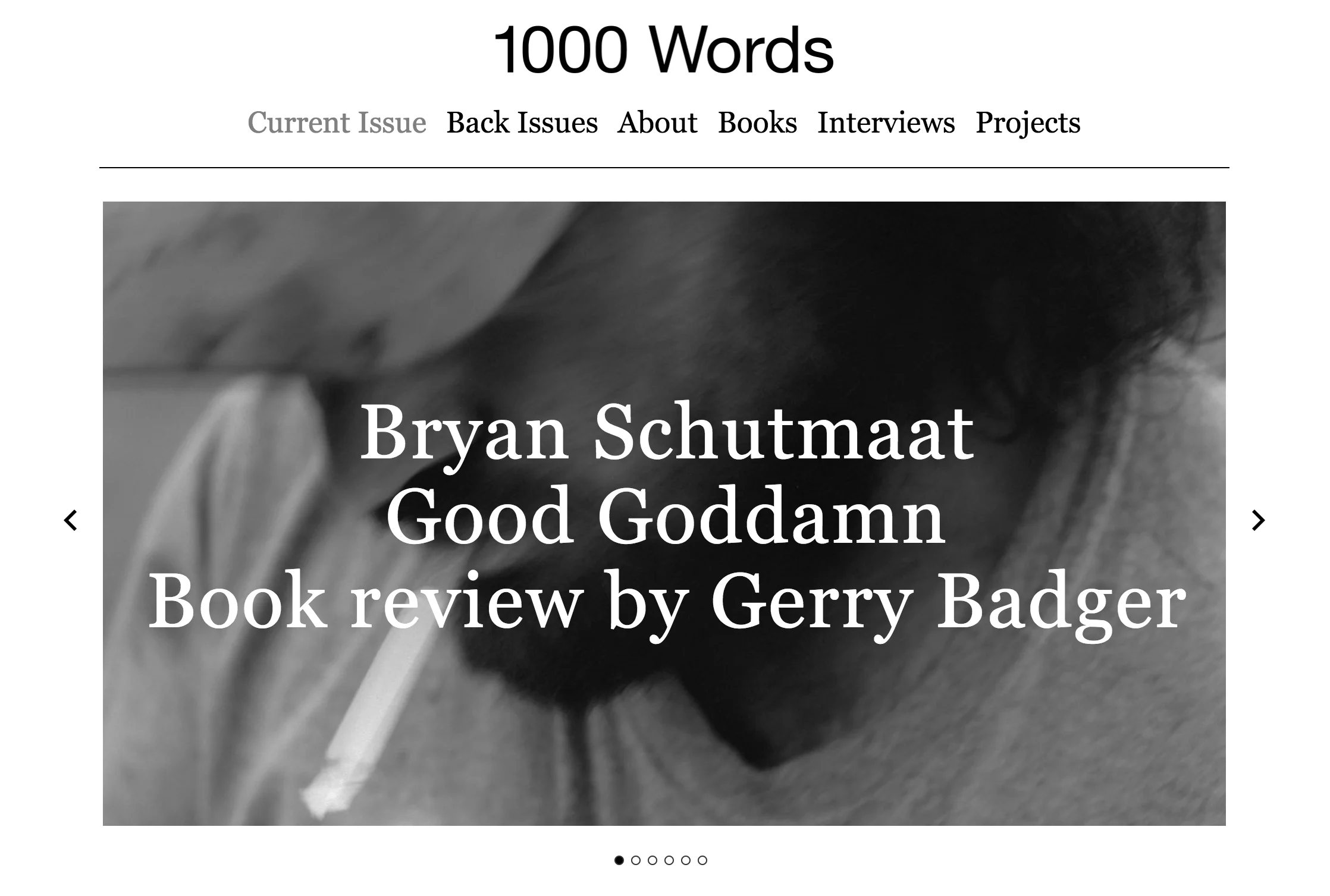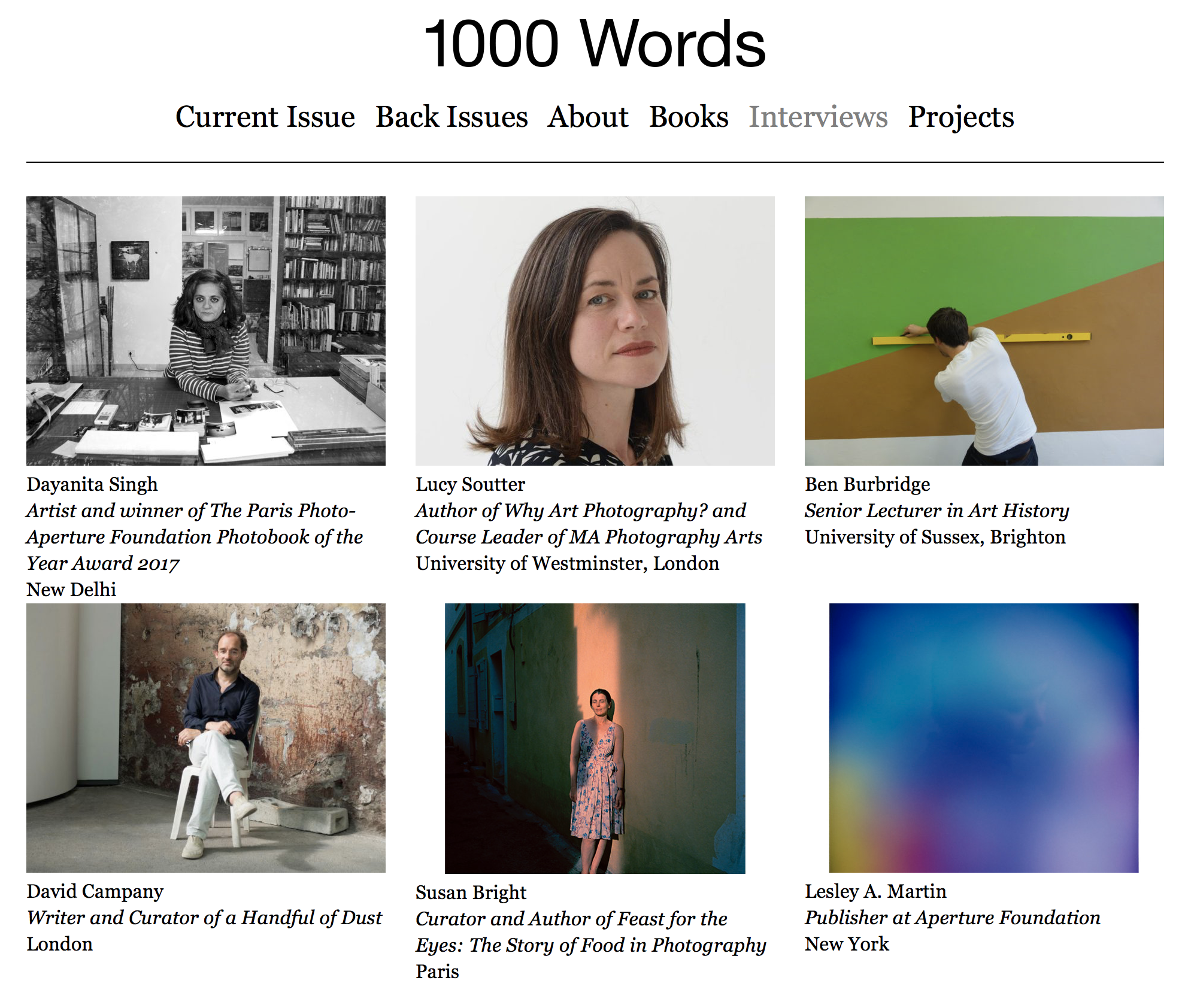Seminal photography journal 1000 Words is doing a Kickstarter to fund its ten-year anniversary issue. You should damn-well support it.
The past decade has seen internet light years of change in the photographic landscape – or at least how it’s exhibited, written about, shared through apps and processed online. Many journals, online magazines, and blogs have appeared and evaporated, but those who have stuck with it have refined their voice and authority by leaps and bounds.
Enter 1000 Words. Launched in London in 2008 by Tim Clark, the online magazine mightily expanded the conversation on new photography with interviews and long-form essays from great minds like David Campany, Susan Bright, and Lucy Soutter. To celebrate its ten-year anniversary, they're launching their first-ever print publication, international photography city guide, and other inspiring projects.
Since 1000 Words has been an invaluable champion of photographers worldwide, we encourage you, dear reader, without hesitation, to support their Kickstarter campaign to fund this celebratory project.
So, hold off on that PBR six-pack, Richard Prince reproduction, or submission fee you were hesitating about spending money on this month and support this project. It’s going to be that good.
On the eve of the campaign launch, we caught up with Tim to discuss 1000 Words' history, inspiration and learn more about the ten-year anniversary project.
Interview by Jon Feinstein
Photos © Esther Teichmann
Jon Feinstein: Congrats on ten years! What initially prompted you to launch 1000 Words?
Tim Clark: Thank you! And thanks as well for hosting me – as you and Amani Olu know, Humble has always been a great source of inspiration. I guess a good point to start talking about the 1000 Words journey is indeed at the beginning, since it really has been a journey with quite naïve origins, to be honest.
I founded the publication in January 2008 – it was one of those lightning bolt moments, really. I remember I was lying in bed feeling lethargic one Sunday morning, and I was considering the gap between the reality of my life and the dreams I had for it and I thought to myself: “I’m going to set up a magazine.”
Feinstein: That's funny. I feel like the biggest lighting bolts come at the most unexpected (and often inconvenient) times. What happened from there?
Clark: In truth, I had already long been writing for a handful of art and photography magazines, but there were so many more portfolios that I was itching to write about, or at least see written about, that I felt the urge to create my own outlet for them. And so 1000 Words was born, with the aim to champion and critique contemporary art photography.
We’re now working on our 28th issue in addition to the special ten-year anniversary print edition, and still continue to publish in-depth exhibition and photo book reviews, essays, interviews in response to the visual culture of our present moment.
© Edmund Clark
Feinstein: I remember when you launched, the online photographic landscape was much different than it is today. The social-media-ization of art-photography was in its infancy. Instagram and Medium weren't around yet. Blogging was just coming off its mid-2000s heyday.
Clark: Now you mention it, it’s extraordinary for me to think that 1000 Words launched before iPhones existed. The first website was beautifully designed by Santiago Taccetti but built on Flash, which had some major shortcomings, and though this served us well up to a point we ditched it as part of the newly designed website that we launched in January 2015, in fact as part of quite a big overhaul.
Feinstein: That's funny! Humble had some of the same original issues – we didn't build in flash, but Amani hand-coded it, so updates were incredibly time-consuming. Since then, many photography magazines and blogs have folded or disappeared suddenly. But you've stuck with it. What's kept you going?
Clark: Personally, I would say a lot of respect and curiosity for artists’ work and a firm belief in the idea that in these challenging times – or transitional phases marked by different crises – the role and value of art and cultural commentary has never been more relevant. This is something I never lose sight of, and feel deeply with passion and a commitment. Something that hopefully gets transmitted through 1000 Words and other projects. Artists have a lot of important things to say, with equally important subjects to explore, which in turn produces a lot of meaning and allows us to look at the world around us in deeper, more probing ways so I see it as a kind of social responsibility to support such activity.
Feinstein: How have you prevailed, made it work beyond the personal investment?
Clark: I hope that it may be due to a strong editorial vision that aims to combine judicious selections of works alongside newly commissioned texts from a network of brilliant writers, who are very active and immersed in the world of photography either as critics, curators, academics and so on.
It’s really the sum of so many great thinkers on the contemporary: Duncan Wooldridge, Lucy Soutter, Daniel C Blight, Susan Bright, David Campany, Gerry Badger etc. Equally valuable are our wonderful readers, of course, as well as the many great partners, advertisers, sponsors, funding bodies and patrons, to whom I am deeply appreciative. Without that healthy mix, it would be impossible to sustain because we don’t have a sales or subscription type magazine model for our online publication.
Feinstein: It's really an all-star roster. Tell me about the city guides you're producing for the anniversary issue. What's the story behind them?
Clark: From Brussels to Milan, Tokyo to Mexico City, we’ll produce a series of city-guides that focus on some of the most engaging international gallery spaces showing photography today. To have these brought together in one publication, coupled by great design and written by industry insiders on the ground in the respective places, will hopefully offer a rich resource into the programmes and defining features of a range of exhibition outlets – from museums and public institutions, commercial galleries to artist-run spaces and so on. It will also no doubt demonstrate the existence of many major art world centers beyond the usual ‘hot spots’.
Feinstein: You're also releasing a print edition for the first time. Why is this particularly important (or interesting to you) now? What's driving this?
Clark: In part, it’s a celebration of the 10th anniversary of the magazine since a decade represents light years in Internet time as you alluded to in one of your earlier questions. And what better way to celebrate than to publish a special print annual? It seems a fairly natural step. We want to exhibit and reproduce in print works by artists who, we believe, have built significant bodies of work and emerged as increasingly influential practitioners in the past decade.
Feinstein: What's it going to look like?
Clark: These high-quality reproductions will be at the core of the 200-page, bookish magazine but obviously, there will be a whole host of other features including profiles on curators or the state of photobook publishing, for example. I’m excited about this new format, the collaboration with the wonderfully talented designer Sarah Boris and all the other editorial features we’ll be able to explore beyond our existing columns and remit of the online publication.
Without wishing to repeat myself, this whole process has got me thinking about what a magazine of the future might look like; its role and value within this digital phase of photographic culture and how our ideas and strategies will need to translate from online to print and then back again – so it’s not an alternative but an addition.
Notions of editing versus curating, to be looked at versus to be read. Friedrich Tietjen put this so elegantly in his paper, Some Notes for the Genealogy of the Photo Magazine during a really stimulating symposium in Liepzig, Germany that I was fortunate to be part of in 2013. He said: “Photography magazines could resemble a catalog for an exhibition that never took place.”
© Laia Abril
Feinstein: A question I've gotten enough times that I feel comfortable asking you: is 1000 Words your full-time job? If not, what else are you working on?
Clark: Very full-time. At least this year, anyway. Usually, I’m part-time on 1000 Words though since I also work as a writer and curator. As Associate Curator at Media Space in the Science Museum in London, exhibitions I worked on included Julia Margaret Cameron: Influence and Intimacy and Gathered Leaves: Photographs by Alec Soth. I left there in April 2016 and was subsequently appointed, together with my colleague Greg Hobson, as Artistic Director of Photo Oxford 2017. This a new, small bi-annual festival in the UK that ran across the month of last September, comprised numerous solo presentations by artists such as Edgar Martins, Mariken Wessels, Martin Parr and Sergei Vasiliev and Arkady Bronnikov from The Russian Criminal Tattoo Archive. I’m also a visiting lecturer on the MA in Photography at NABA Nuova Accademia di Belle Arti Milano, Italy.
Currently, Greg and I are working on a book with material drawn exclusively from the Daily Herald Newspaper archive that looks at the ambiguous use of press photography in terms of presenting innocence and guilt, as soon through the prism of various stories on famous English murders. I’ve also been asked to develop proposals to curate a strand of an art fair in 2019 and for a guest curator position at another fantastic festival in Europe for 2020 so let’s see where that leads me – parallel to 1000 Words – in the coming years.
© Jose Pedro Cortes
Feinstein: What advice would you give to aspiring publishers and/ or photographers trying to get their work in front of a larger audience?
Clark: When I was in the process of setting up 1000 Words, I sought advice from a good friend who ran a well-respected and long-standing photography magazine here in the UK. He gave me two succinct tips. He said: “Get a partner, and be prepared for it take over your life.” I remember it clear as day. How right he was!
With regards to advice for aspiring photographers, it sounds obvious but I would venture the following: first and foremost, identify the right people and correct platforms with whom your work may resonate. Then try to see them at a portfolio review event or book a private appointment. If this feels unattainable then perhaps ask a mutual contact to broker contact. Though don’t hassle those on the other side. Perseverance is key, but hounding is really not advised. It’s just so off-putting.
Remember curators, publishers, editors and so on don’t just spend their days looking at great new photography as much as we wish we could. Our schedules and workloads are often admin heavy, and with a wide range of responsibilities to boot, so don’t feel offended if you don’t receive really detailed feedback, especially if there is no pre-existing relationship. Equally, you’ll be amazed how much support you may be able to garner when the alignment of interests is right.
Feinstein: What's the most remarkable change you've noticed in the photographic landscape over the past 10 years?
Clark: These have been so vast and radical – from the advent and impact of social media to photography’s expanded realm of three-dimensional or process-driven works – it’s a challenge to neatly contain my thoughts here. But perhaps we can consider the resurgence in interest in the photobook briefly. It’s absolutely exploded in the last 10 years and I’m delighted to see the space for its production, culture, and study ever increasing. Think of all the new publishing imprints that have arrived on the scene and naturally the countless awards, prizes and book fairs that have emerged to give a platform to such endeavors. Does a rising tide raise all ships though?
Not always, as the economics is incredibly difficult in that field and perhaps we are witnessing a moment of reflection of where it’s headed. One thing for sure, however, is the sheer creativity we’ve seen, particularly within the self-published and independently published worlds, which has dramatically reinvented the book as both a primary vehicle for artists’ ideas and a key way to launch a career.
What are you most excited about in years to come?
Professionally speaking – the new collaborations with artists for the various projects that I mentioned before – those that I have known for years and followed their practice as it has developed, as well as all the new people I’ll meet and get to work with and support along the way.









